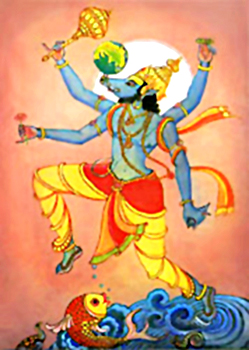 Content of Varaha Purana essentially deals with the Varaha avatar of Lord Vishnu and the rescue of the world from Rasatal. It is said to have been recounted by Lord Vishnu, to Prithvi, and narrates the way in which he saved the world from Rasatal in his Varaha avatar. The Varaha Purana in essential depicts the sinful existence of man in Kali Yug which led the earth to Rasatal. The human beings due to their sins have to suffer inevitable and inescapable atonement. The verses of the Varaha Purana, depicting the significance of Vratas lead the mortals to perform hard penitence in order to get rid of their agonized existence in the Kali Yug.
Content of Varaha Purana essentially deals with the Varaha avatar of Lord Vishnu and the rescue of the world from Rasatal. It is said to have been recounted by Lord Vishnu, to Prithvi, and narrates the way in which he saved the world from Rasatal in his Varaha avatar. The Varaha Purana in essential depicts the sinful existence of man in Kali Yug which led the earth to Rasatal. The human beings due to their sins have to suffer inevitable and inescapable atonement. The verses of the Varaha Purana, depicting the significance of Vratas lead the mortals to perform hard penitence in order to get rid of their agonized existence in the Kali Yug.
The Varaha Purana primarily depicts earthly matters and provides an illustration of the miseries and happiness on earth. Several tales in this Purana are composed in a way, which differentiates between sorrow and happiness in the mortal world. Moreover the Varaha Purana describes 12 kinds of crime, penance to destroy the sins, methods and ritualistic sacrifices of the Vishnu worship in the evening, description of Sanatan Dharma, description of illusion, description of the Karma for salvation, history of Gridhra and Shringali, dialogue between Chandal and Brahmarakshasas, greatness of Kokamukh, greatness of Badrikashrama, greatness of Mathurakshetra, greatness of Shalgram, tale of Shalankayank, greatness of Lohargalam, Vishran tirth and Devavana, worship of Lord Vishnu at the confluence of River Yamuna - River Saraswati, greatness of Krishna Ganga, tale related to Samba, significance and implication of Dwadashi Vrata in Rama Tirth, rituals and sacrament ceremony of installing different kinds of idols, description of the origin of Shraddha, methods of removing impurities, Medhatithi Pitrasambad, kinds of Pindasankalpa, ritual of Madhupark, kinds of Madhupark donations. The significance of these Vratas and sacrifices are all described in the Varaha Purana. It is said in this Purana that the miserable mortal existence will be relieved only after the strong penance and performance of Vratas relating to the worship of Lord Vishnu.
The Varaha Purana deals with the Kali Yug on earth in general. Hence it has a thorough description of mortal existence, its destruction and ultimately its journey to Yamalok. In this Purana there is found the detailed description of the appearance of Lord Yama as the authority of Yamalok, description of the court of Yama, description of the fate met by sinners, description of hell, description of the appearance of Yamadoot, description of Chitragupta`s effect, directions by Chitragupta for expiation, indications by Chitragupta of the fruits of auspicious-inauspicious Karmas, description of Pativrat, dialogue between Yama and Narada, greatness of Prabodhini, description of the greatness of Gokarneshwar, granting of boon by Nandikeshwar, description of greatness of Jaleshwar and description of the greatness of Shringeshwar.
In its mode of discussion the Varaha Purana also discusses some other topics with detailed illustration. Mangala Charan, a significant part of the Varaha Purana, is mainly concerned with subjects like praying of Narayana by Prithvi (earth), tale of Creation, origin of Rudra, Sanatkumar, Marich etc., tale of Priyavrata, tale of Dashavatar (ten incarnations), tale of Dharma Vyadha, tale of Suprateek and sighting of Viratroop (colossal appearance), tale of Gaurmukha, Karma related to Shraddha, tale of Prajagana, origin of Agni (fire), tale relating the greatness of the days, Gauri, destruction of Daksha Yagya, wedding of Har Parvati (popularly known as Shiv Parvati), Ganesha, Naga, Kartikeya, Aditya, killing of Andhakasura, Matrigana, Katyayani, Kumer, Dharma, Rudra, etc. and their origin, tale of Aruni, tales of the days falling in different months, Agastya Geeta, tale of Shubhvrata, tale of Dhanyavrat, dialogue between Narad and Vishnu, methods for expiation, tale of Agastya, geographical description of Jambudvipa, Kushadvipa, Kraunchdvipa, etc., tale of Andhakasura`s Vrata, etc., origin of Vaishnava, killing of Mahishasura, ritual of Kapalik Vrata, dialogue between Prithvi and Sanatkumar, dialogue between Narayana and Prithvi etc.
Thus given above is a deeper insight into the content of the Varaha Purana.



















